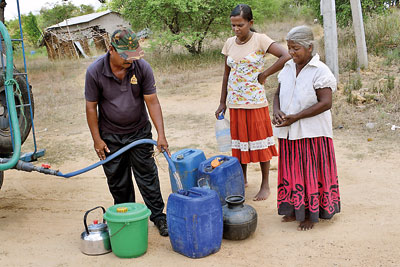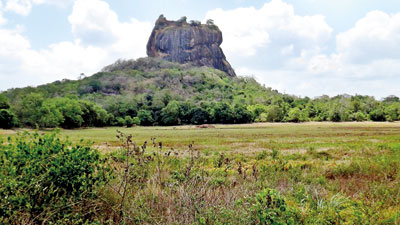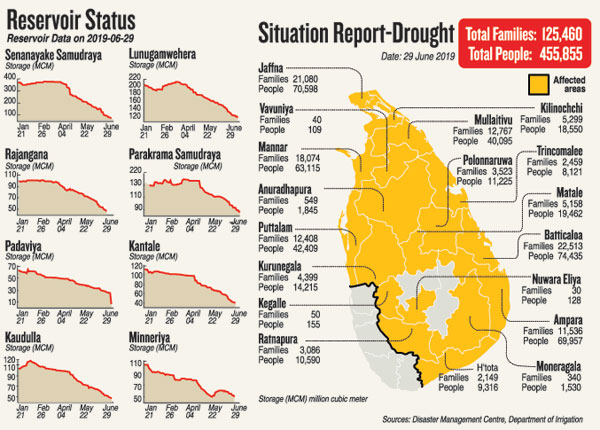News
Drinking water drying up in parched east

Residents of Kaduruwela queue up for drinking water. Pic by Karu Gamage
Almost half a million people lack drinking water and there is no hope of a turnaround for five long months as the drought causes widespread hardship across 15 districts, especially in Batticaloa and Ampara.
District secretaries have informed authorities they are finding it difficult to locate drinking water sources for the 450,000 people in need of sustenance.
Livestock are dying of thirst in the east.
The huge, 2.5km-long Unichchai Tank that supplies Batticaloa town with water and supports farmers for miles around has only seven feet of water, down from its 33-foot-high normal capacity, Batticaloa District Secretary M. Udayakumar said.
“Seven feet of water is what is left. It is the main source of water for cultivation and drinking. Apart from that, there are few wells that still retain water. That well water is used only for drinking purposes and distributed via bowsers,” Mr. Udayakumar said.
There are 40 bowsers in operation across the district. Wakare, Koralepattu South, Puttur, Vavunathu and Wellavali are the hardest-hit areas.
Pipe-borne water to Batticaloa has been reduced in order to preserve water and distribution through bowsers was limited as the nearest water sources to most areas facing drought are drying up, Water Board chief D.U. Sumanasekara said.
Crop estimates are sharply down because little water is available. Some irrigation tanks have dried up and the remainder have just a few feet of water left, the Irrigation Department said.
“The water levels at the reservoirs are going down; most tanks in the Batticaloa region are nearly empty,” the Director-General of Irrigation, S. Mohanarajah, said.
“Even the Mahaweli River is drying up. The water flow of the river has stopped, with only some stagnant pools in certain areas of the river.”
Mr. Mohanarajah said there would be a wait of another five months without rain until the north-eastern monsoon arrives.
He said there might be just enough water in Batticaloa and Ampara reservoirs to sustain crops for a few days until the Yala harvest but had a grim forecast for farmers who did not heed the department’s advice to sow crops with a short growing period in view of the limited water supply.
“Farmers who did not heed our advice or who sowed crops late will be affected,” he said. “They will find it hard to even locate ground water as ground water levels would also drop as the tanks run dry.”
The Yala harvest could drop by a third, the Department of Agriculture fears.

Dried up Sigiriya Wewa. Pic by Kanchana Kumara
The department’s Director-General, Dr. M.W.M. Weerakoon, said crops had been expected from 400,000 hectares of paddy land but now officials believed that with water in such short supply only 250,000 hectares would yield grain.
Mr. Mohanarajah said while Batticaloa and Ampara were suffering the worst, the distribution of water in Polonnaruwa was, at least for now, in a better situation as water was being channelled to tanks in Kantale from the Moragahakanda reservoir. Disturbingly, the Senanayake Samudraya in Polonnaruwa was only 8 per cent full, he added.
In Puttalam, authorities are hard-pressed to provide relief to more than 40,000 people in hardship.
Puttalam District Secretary N.H.M. Chithrananda said he had been sent bowsers and Rs. 1 million to employ people to run them but the main problem remained.
“The issue is that we are unable to find water sources capable of providing drinking water,” he said.
His officers have placed tanks of 100-500 litres in city areas for people to take water and have started building rainwater collection tanks at remote areas where bowsers cannot travel.
The Meteorology Department issued a heat warning for Polonnaruwa, Batticaloa and Ampara, urging people to take extreme caution and said rains were not expected in the country’s east until October at the earliest.
Director (Forecasting) Anusha Warnasooriya said occasional thunderstorms in the area had failed to bring sufficient rain to sustain the rivers or fill up irrigation tanks.

| Build tanks in Wet Zone, water chief urges More reservoirs must be built in the Wet Zone to collect river water for distribution to areas facing drought, Irrigation Department Director-General S. Mohanarajah says. He pointed out that the Kelani River, Gin Ganga and Nilwala Ganga had good water levels but there were no storage tanks to harvest their water for times of need in the arid zone.“We predicted this situation and notified the relevant authorities including the Disaster Management Centre (DMC). They must take quick action and find solutions for the drought and provide relief to the people affected,” Mr. Mohanarajah said. DMC Deputy Director (Early Warning) Pradeep Kodippili said bowsers had been sent in required numbers to all districts along with funds to provide relief to people suffering because of the drought. “We are sending Rs. 1 million to each District Secretary and will provide more money if requested,” he said. | |

